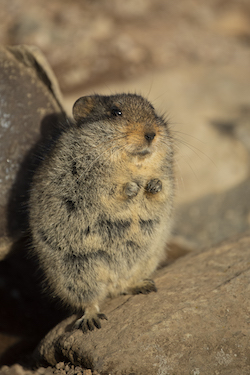Eland Taurotragus oryx
The world’s largest antelope, the eland is a rather bovine creature that weighs in at up to 950kg. It is the mammal most widely associated with the Maloti-Drakensberg, in large part due its deep spiritual significance to the San (bushman) artists who once inhabited the mountains. The eland is the most common non-human subject depicted in Lesotho’s prehistoric rock art, and it is quite easily seen in the flesh in Ts'ehlanyane National Park and to a lesser extent Sehlabathebe National Park.
 Sloggett’s ice-rat Myotomys sloggetti
Sloggett’s ice-rat Myotomys sloggetti
Rodents wouldn’t normally feature on a list like this, but this peculiar short-tailed rat - which has the squirrel-like habit of standing upright and lifting its forelimbs to its chest - is an endearing exception. Endemic to the Maloti-Drakensberg, its range is confined to moorland above the 2,500m contour, where it forms an important source of nutrition to Verreaux’s eagle, jackal buzzard and other raptors. It is particularly common and conspicuous in the vicinity of Sani Top.
Chacma baboon Papio ursinus
Hikers and pony trekkers in Lesotho may well hear an occasional hoarse bark echoing from high on the cliffs. This is the intimidating warning call of the Chacma baboon, a sociable, intelligent and rather doglike large monkey often regarded as a nuisance elsewhere in southern Africa, where habituated individuals have learnt to intimidate humans to obtain food. Fortunately, the baboon troops of Lesotho tend to be shy and to maintain a watchful distance from passing hikers.
.jpg) Drakensberg rockjumper Chaetops aurantius
Drakensberg rockjumper Chaetops aurantius
This striking orange-breasted bird is the most colourful of several restricted-range passerines associated with the highlands of Lesotho. It is one of only two species in the Chaetopidae, a localised bird family endemic to the mountains of South Africa and Lesotho. Pairs or small parties that frequently raise their tail as they run and hop between the rocks where they forage openly for insects, scorpions and other invertebrates.
Bearded vulture Gypaetus barbatus
The highlands of Lesotho are an important breeding stronghold for cliff-nesting raptors such as the near-endemic jackal buzzard and Cape vulture. It also hosts the southern hemisphere’s only breeding population of the truly magnificent bearded vulture, which is easily recognised by its long narrow wings, wedge shaped tail, wingspan of up to 2.75 metres, and sideburn-like ‘beard’ for which it is named. Unlike other vultures, it favours bone marrow over flesh, and it will customarily drop bones from a great height to crack them open. It is also widely known as the ‘lammergeyer’, a German name meaning lamb-eating vulture.






Comments
Nobody has commented on this post yet, why not send us your thoughts and be the first?
Leave a Reply